A Sophisticated Provincial by Margo Alexander
There is very little information available online about the California artist Margo Alexander, and that is a shame. I was recently fortunate enough to pick up a small and interesting piece by her and I wanted to make sure to share what I knew about her online. I don't know the title of the piece, but it's one from a series she called Sophisticated Provincials, and they are still widely available at reasonable prices on ebay.
Margo Alexander was a muralist and printer who ran a large art studio in California in the first half of the 20th century. Here's what it says about her in Emerging from the Shadows.
In Los Angeles, she established her reputation as a muralist, creating custom murals for private homes and public buildings. As in her oil and watercolor paintings, her mural subjects included figurative, landscapes, still lifes, and genre scenes. She also designed fabric, china, and table linens. By the early 1940s, she employed six full-time artists at her Los Angeles studio to assist with mural commissions and with her more commercial production of serigraphs, which she called "Sophisticated Provincials," which were created using a hand reproduction technique she developed that attempts to retain the spontaneity of an original painting. These were simply signed "Margo."
What I think is interesting about Alexander is that she was commercializing screen prints in a way very similar to what Andy Warhol claimed credit for decades later. She was pumping out these small, semi-handcrafted works that were designed for the mass market. It's true that these small, quaint scenes haven't withstood the passage of time as well as Warhol's, but I still think she needs to be put in the same context as Warhol.
Here's the piece I picked up for $8 on ebay. It's only about three inches square.


Here's what it says on the back, if you're having a hard time reading the small print.
Widely recognized for the dash and color of her original paintings and murals, this popular western artist strove to develop a hand-reproduced technique retaining all the piquant spontaneity of her prized originals.THIS, with the support of her associates, Ann Bode and a talented staff, in the seclusion of her tree-covered old-world studio, she has achieved and proudly presents herewith her original hand-replica of...
I can't read what was originally in the box at the bottom, so I can only speculate at the title.
I hope that by putting this online I can preserve some memory of an artist who was successful enough to run her own store in Los Angeles for decades.
Goodbye to Zadie Smith, Doris Kearns Goodwin, and Aubrey Beardsley
I am definitely a book hoarder. I love my books. I love the smell of the paper. I love the sound the spine makes when you open it for the first time. I love the way a bookmark looks when it's peering out from the middle of the book, keeping your spot for you.
It's hard for me to let go of books, but since I live in a relatively small house in California, I have to make a habit of getting rid of books every few months. I usually take them down to a Little Free Library, or to Goodwill.
But I've decided to start blogging about the books I donate, so that I can remember them on the internet, even if they aren't on my bookshelf.
Here are the books I'm saying goodbye to today.
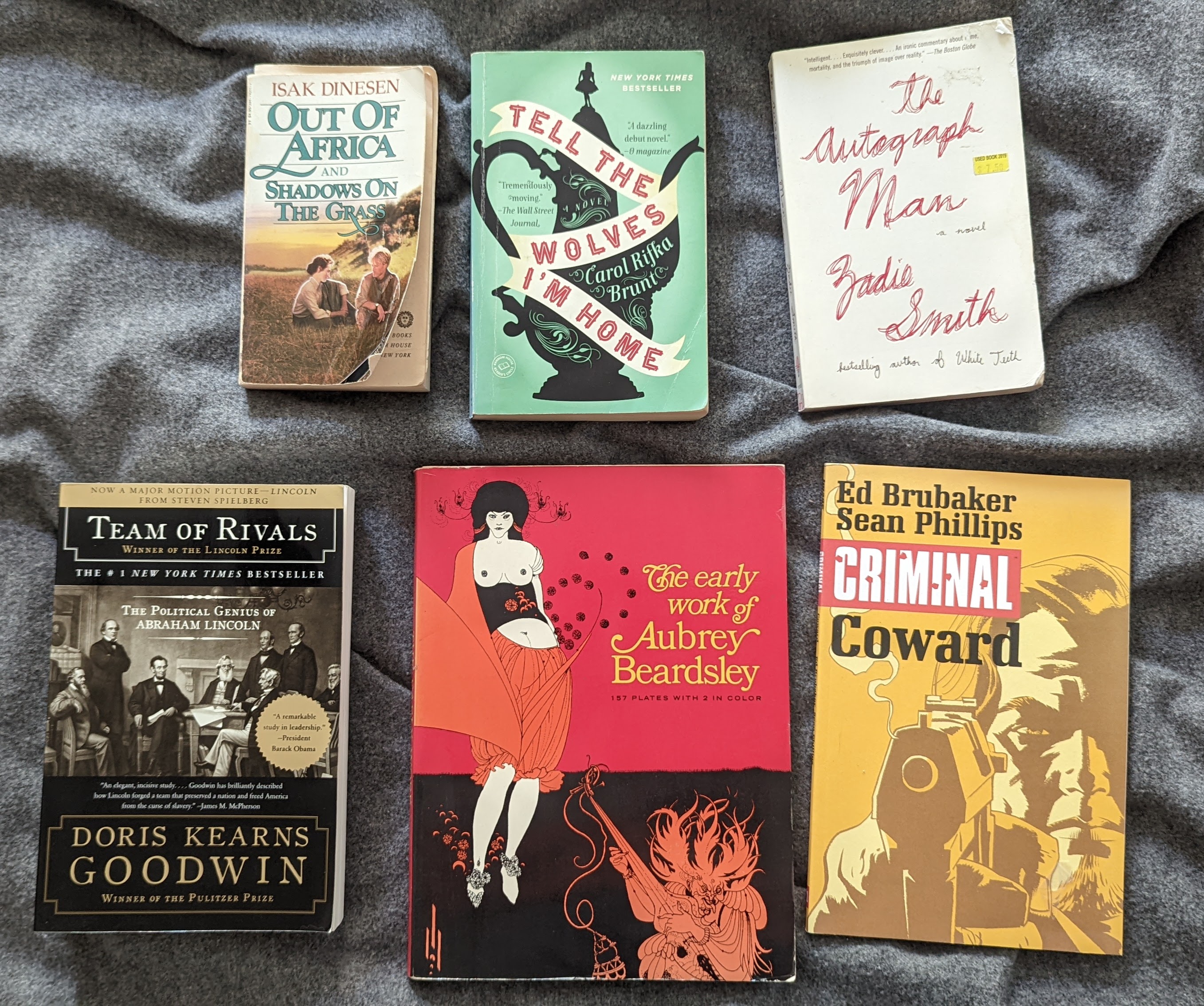
Out of Africa by Isak Dineson
I love the way Isak Dineson writes. Her words ache with empathy and bittersweet longing for things she can never possess. Of course, she's writing about her time as a colonizer, and that throws a disagreeable shade over her work. But her memoir of colonial Africa in the early 20th century is still marvelous and fascinating.
I pulled this copy out of a Little Free Library in my neighborhood, and it wasn't in very good condition when I found it. The cover is battered, and some pages are falling out. Still, I think it will serve a few more readers, so I am taking it back to where I found it.
Tell the Wolves I'm Home by Carol Rifka Brunt
This book made me cry at the end. I loved it. My wife gave it to me after she finished it.
I love media that is set during the AIDS crisis. Maybe it's a little dark to admit that, but I just love the gay art scene of the 1980s in New York and London. As pointed out by Rent, there is a romantic pathos about making art and dying for love, and this book captures it so well.
The Autograph Man by Zadie Smith
The Autograph Man is not my favorite book by Zadie Smith, but nothing she writes is bad. I like the way she gives us these windows into subcultures that feel so authentic. In this case, it's a window into the life a Jewish man who buys and sells autographs.
My wife read this book, then passed it on to me.
Team of Rivals by Doris Kearns Goodwin
I was gifted this book for Christmas a few years ago. Team of Rivals is truly one of the great books about Abraham Lincoln and The Civil War, and there are thousands upon thousands of books on those topics.
Still, I think this book could have been 150 pages shorter and achieved the same thing. I'm not sure that hundreds of pages about the early lives of Lincoln's cabinet members really informs the story about their decisions during our greatest national crisis. It took me nearly two months to get through this book, but I'd still recommend it to history buffs.
The Early Work of Aubrey Beardsley
I went through a brief love affair with Aubrey Beardsley's work, and it still amazes me to see illustrations produced in the late 19th century that were so influential on later art. Many of Beardsley's illustrations look like they would be more at home in the psychedelic posters of the 1960s San Francisco rock scene. I would love to be able to pick up one of his original prints, but the market is saturated with reproductions and fakes.
I picked this book up for two dollars at an estate sale. I hope it introduces someone else to the brief career of a very influential illustrator.
Criminal Volume 1 by Ed Brubaker
Most comicbook readers will recognize this one. I've enjoyed a lot of Brubaker's work, but this one just didn't pull me in, despite being heavily recommended.
Save the planet. Wear a hat
One of the odd sacrifices of our modern way of life is hats. Hats used to be everywhere. Everyone wore a hat every day. Just look at this 1940 painting by Jacob Lawrence. Do you see anyone not wearing a hat?

Why did everyone wear a hat? Because their hair was a greasy mess. Today we tend to shower more often than our ancestors, so we've dropped some of the layers of clothing that they preferred, including hats.
People still wear functional hats. Baseball players need to shade their eyes from the sun. Construction workers and football players need to protect their fragile skulls.
People also wear hats that form part of their uniform. The pope's hat is particularly famous, and the Queen's Guard wouldn't look right without their characteristic bear skin hats.
But outside of the occasional horse race, nobody wears big, fancy hats any longer. Like when was the last time you saw someone wearing hats like the ones worn by the Duke and Duchess of Urbino in this dual portrait by Piero della Francesca?

I think I'd look good in that giant red hat.
And anyway are we really better off showering every day? Between the dry skin and the lack of hats, I'm not entirely convinced.
Plus, showers are a massive waste of water and energy. I know I don't need to turn the hot knob all the way up, but I can't help myself. So the planet would be better off if we skipped a shower now and then.
And that would be much easier to do if I owned a few good hats. One artist who definitely liked a fancy hat was Rembrandt van Rijn. I had a hard time picking just the right self-portrait to feature in this post, but I think this hat with two feathers down the front would turn a few heads if someone was bold enough to bring it back.

So if you are a connoisseur of haberdashery, and you care about the planet, then do yourself a favor; buy a fancy hat and skip the shower.
Neglected by Sam Hyde Harris
A few months back I saw an absolutely gorgeous painting come up for auction. The listing said it was by one of my favorite artists, Sam Hyde Harris. Unfortunately, the painting was unsigned, and it was listed at a pretty low price. Both of these things gave me pause while considering bidding on it. We all know how common fraud is in the art world. How could I be sure that this piece was genuine?
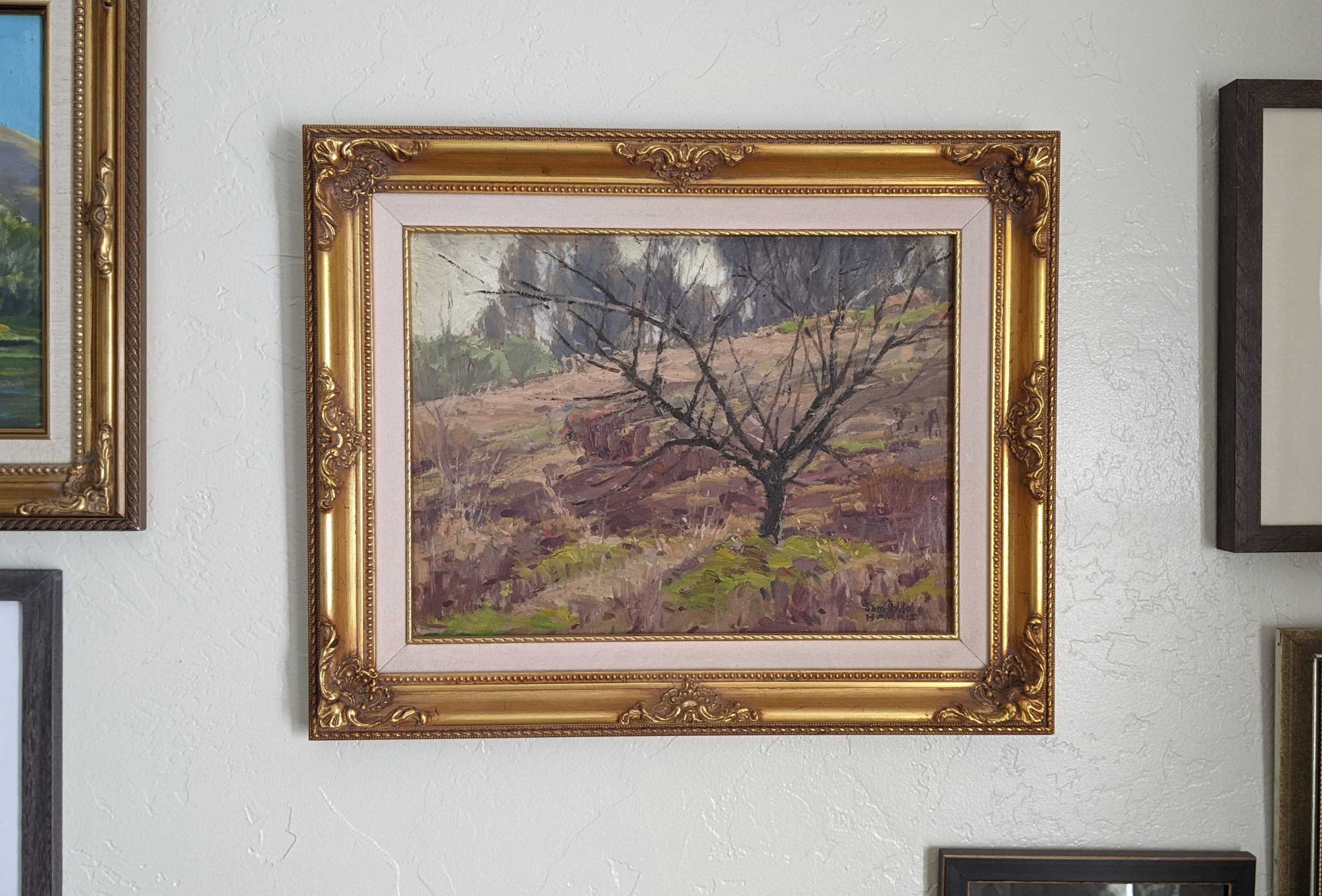
You can never be 100% sure that a piece is genuine. This is doubly true in an online auction where you can only see a handful of pictures of a piece. There were several aspects of this piece that made me think twice.
- It was unsigned
- It was a slightly unusual composition for the artist
- It was listed at a lower starting price than most pieces by Sam Hyde Harris
I took a risk on the piece anyway, and I managed to pick it up for a very reasonable price.
But that was only the beginning of the journey. Once I got the piece in my hands, I tracked down the Sam Hyde Harris expert Maurine St. Gaudens. Maurine literally wrote the book on Sam Hyde Harris, and she had the documentation from his estate to be able to conclusively prove whether a piece was by him or not.
Harris was a member of a group called the California Impressionists, so I wasn't surprised to find that Maurine was located in California. After speaking with her, I agreed to bring the painting down to her studio in Los Angeles, where she could authenticate it.
Maurine is an exceptionally interesting person. She is a tiny woman around age 70 with long brown hair down her back. She is an art conservationist, so her studio is absolutely overflowing with art. Her own collection hangs in every available spot on her walls, and the standing room is filled with paintings that she is working on.
Her collection includes dozens of paintings by California artists of the 20th century, and especially female artists about whom she also wrote the book.
When I arrived at her studio there was a very tall man wandering around as well. He turned out to be the noted Sam Hyde Harris collector Charles N. Mauch. When I handed the painting over to Maurine for authentication, Charles took me back to a garage and started showing me more paintings by Sam Hyde Harris. It turned out that they still had some paintings left over from his estate, and I was welcome to look through them and maybe even purchase a few (more on that in a future post).
Here's one of the beautiful pieces that Charles showed me.
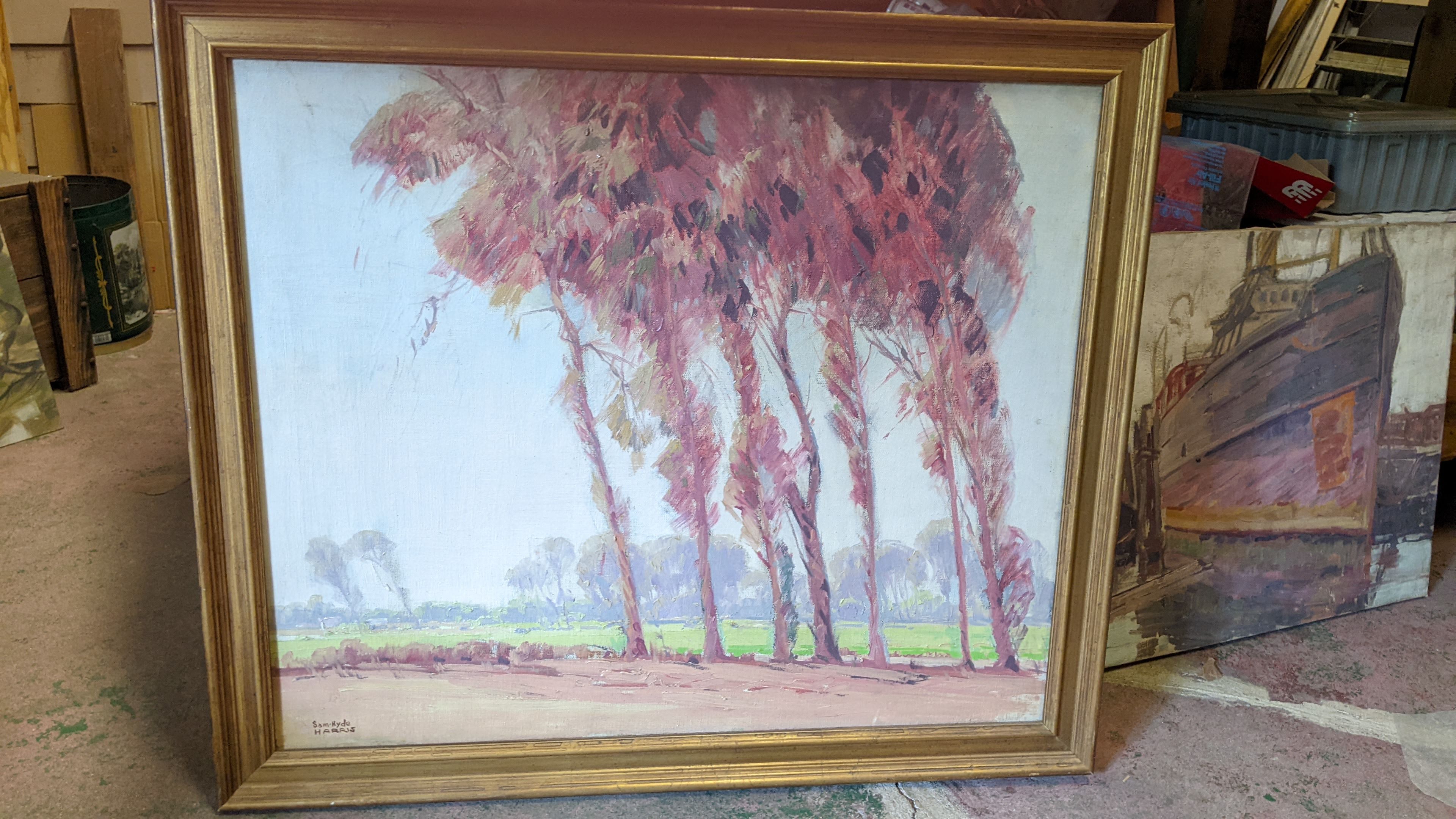
When Chuck and I were done browsing the wonderful paintings in Maurine's garage I finally made my way back to her studio to hear the verdict.
Maurine was happy to tell me that the painting was a genuine Sam Hyde Harris. She was able to verify this in two ways. First, she found the painting in the inventory made by the estate when Harris died. Second, she had actually seen other versions of this painting. It turns out that Harris made multiple sizes of most of his paintings. He first made a sketch, then a very small study, then a 12x16 version, and finally a larger version. She had seen the larger version of my painting in the past, so she knew that mine was indeed legitimate.
She was also able to tell me, based on the inventory number, that the painting was created some time in the 1930s. So it's a relatively early easel painting for Harris, because at that time he was more focused on his career as an illustrator.
She authenticated the work by painting her mark on the front and signing the back. I drove it back to San Jose, where it now sits above my desk. I think it's one of my favorite pieces in my collection right now, along with the big Quincy Tahoma painting that I had restored.
Buying a painting like this at auction is always a bit of a risk, but in this case the risk paid off in spades. Not only did I get to hang a beautiful piece of California history on my wall, but I also got to meet some amazing people. It goes to show how a great piece of art can inspire and unite people even many years after its inception.
Discovering Bay Area linocut artist Melissa West
Yesterday I went to the SF Bay Area Printers' Fair and Wayzgoose. It was a fabulous and interesting event. I was so glad to see prints by so many local artists and printers. I enjoyed talking to everyone I met there, but I spent the most time at the booth of artist Melissa .
Most booths at the fair had around a dozen different prints to peruse, but I was blown away by Melissa's prolific output. Melissa must have had close to 100 unique pieces there if you don't count the 50 she did as illustrations in a book she was selling. Every piece was a handmade linocut with no digital processes involved. I spent time leafing through every single piece there.
Another thing that impressed me in West's work was her textual fluency. Her work incorporates numerous references to other works of art and culture. She had many pieces that mimicked style elements in medieval art, including a series about saints that portrayed figures in a Byzantine style. I particularly liked St. Christina the Astonishing.
I was also impressed simply by the quality of her work. Despite her massive output, every piece reflects a fluency with linocut that I see in very few artists. She has clearly devoted a lot of her life to the craft, and the time has been well spent.
As usual, I picked up a couple pieces to add to my own collection. I think this surreal landscape will look great next to my pieces by Sam Hyde Harris.
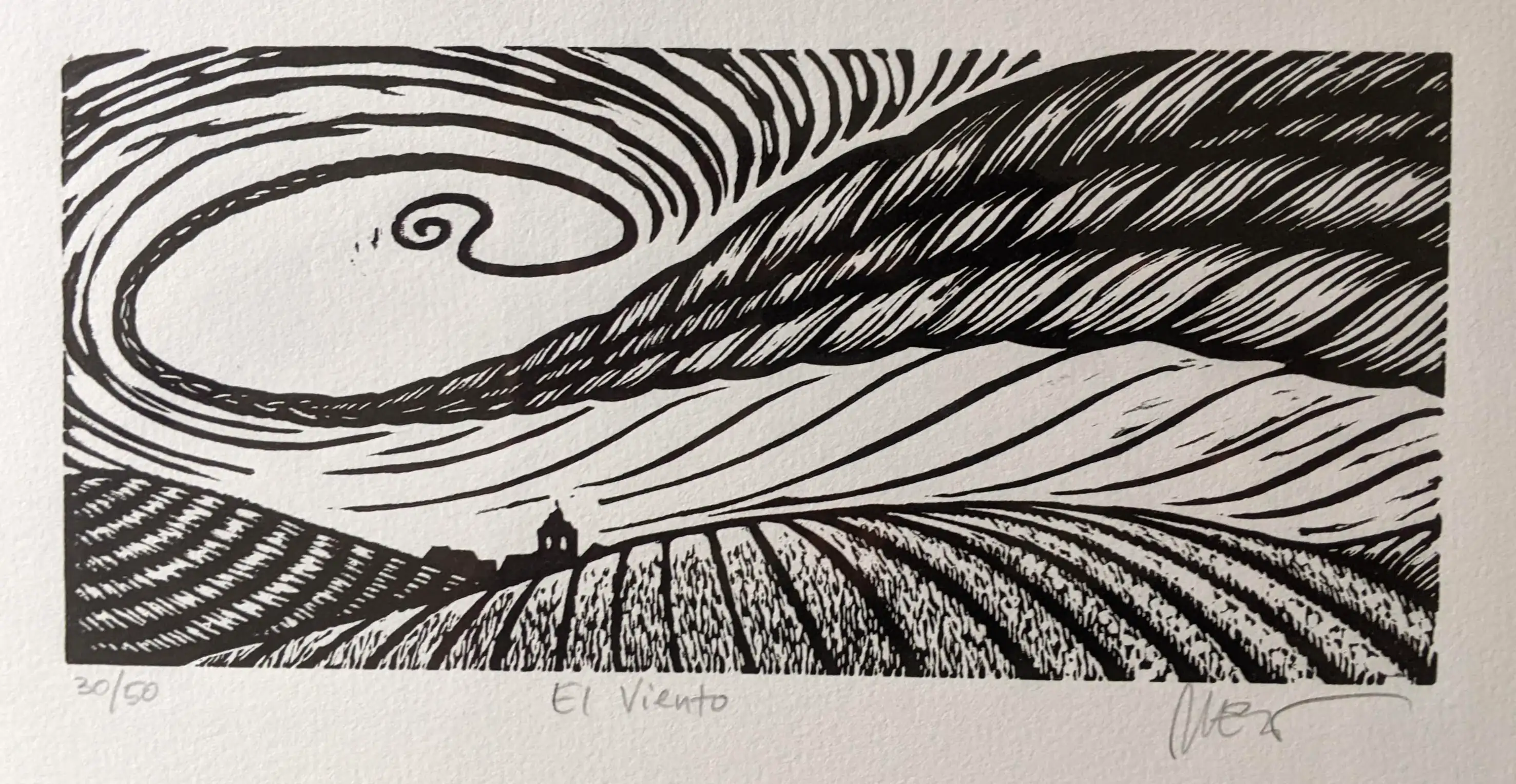
And this piece made me laugh. I think it will look good in my in-laws' house. Their house is adorned with artifacts relating to vehicles and travel.
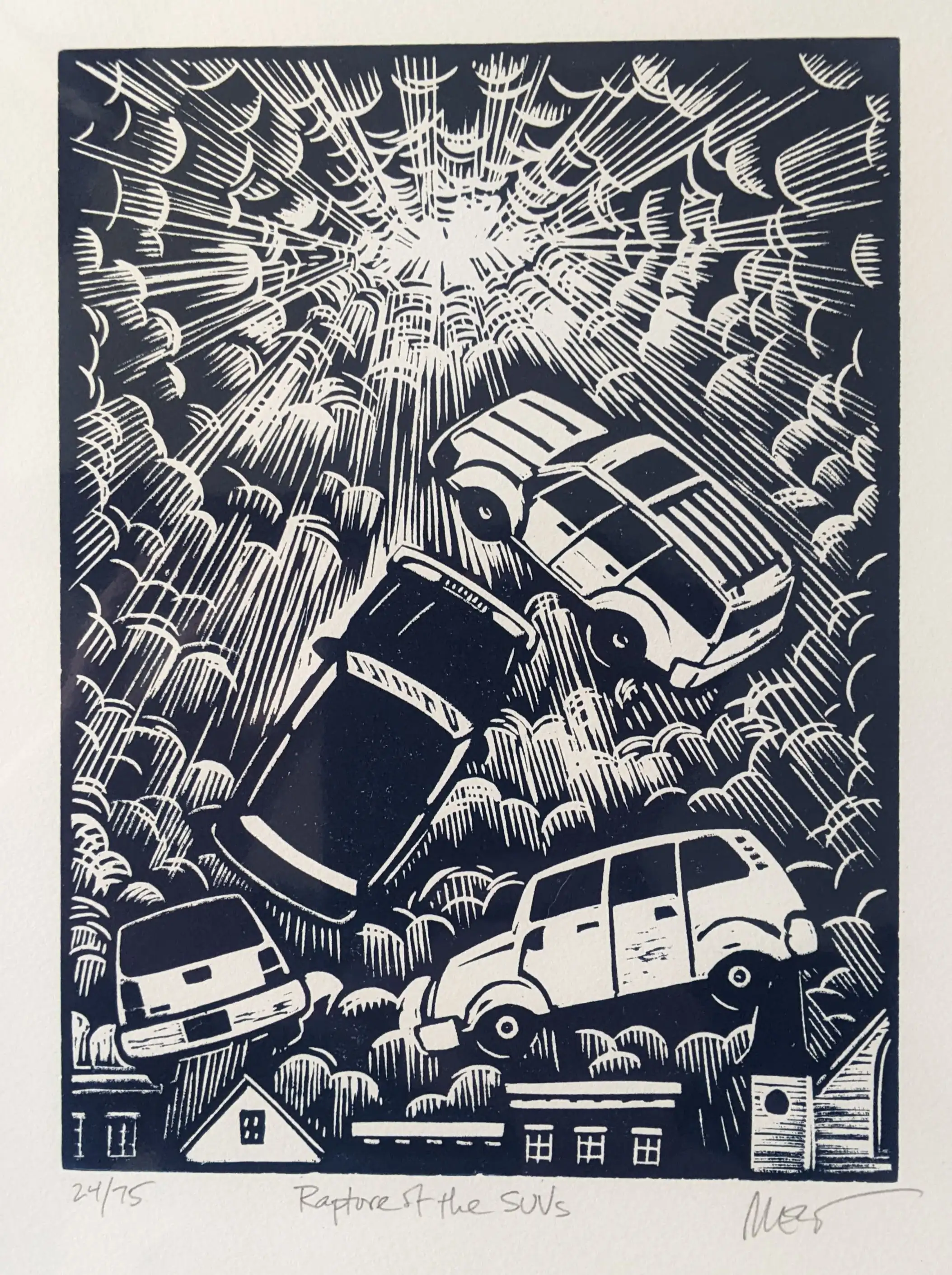
I encourage you to check out Melissa West's work and pick up a print. Put something beautiful on your walls.
